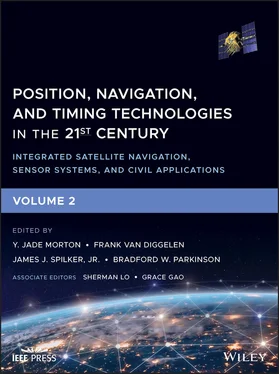Evaluation metrics. Indoor localization solutions in the literature are compared using various metrics such as the average location error, RMSE, 95th percentile, and so on. However these metrics often do not capture real‐world variations. For instance, [165] discussed how certain indoor locales were very easy to localize by even the simplest of techniques; however, some other points were extremely difficult to accurately localize. The way in which evaluation points are selected and weighted in the evaluation metric is therefore crucial, and a lot of work needs to be done in terms of standardizing the evaluation metrics of indoor localization technologies to properly capture these parameters.
Sensor positioning. Many indoor localization techniques rely on readings from sensors that are carried by the person or object to be tracked. It is possible for the orientation and position of the sensors to change over time and across tracked subjects; for example, a person may carry a smartphone with inertial sensors in different pockets, or hold it in their hand when moving. There may also be other types of positioning issues; for example, the direction a smartphone is facing may be different from the direction the subject is moving. Indoor localization techniques should take such factors into account and compensate for positioning variations. For better accuracy in the estimation of the step length or even the heading direction, it may be preferable to use foot‐mounted sensors [166]; however, this usually comes at the cost of user inconvenience.
Sensor calibration. Many of the sensors used for indoor localization have an inherent bias and variations in sensitivity to environmental factors. In particular, the low‐cost and compact MEMS inertial sensors found in smartphone IMUs have inferior sensor screening, installation error calibration, cross axis error calibration, zero point correction, temperature drift compensation, and so on, compared to the more accurate (and thus bulkier and more expensive) IMUs used in unmanned aerial vehicles (UAVs) and other industrial applications [138]. The IMU sensors must therefore be individually re‐calibrated when in use, to avoid drifts in outputs that result in increasing errors over time.
Battery power. Indoor localization techniques that rely on mobile devices carried by moving subjects need to be aware of the battery life constraints of the device. If excessive computation or sensing is performed with the mobile device, the battery of the mobile device can drain quickly, and this is an extremely undesirable scenario, especially if it happens during navigation. For example, if smartphones are utilized for indoor localization, care should be taken to limit the use of CPU, GPU, or DSP processing; wireless radio modules (e.g. Wi‐Fi, 4G/5G cellular, GPS); and inertial sensors, as all of these when used continuously or in combination can cause the smartphone battery to drain very quickly. Techniques to optimize energy efficiency in mobile devices [167–170] will be key to achieving cost‐effective and practical indoor localization solutions.
Processing capability and memory constraints. Many indoor localization techniques rely on algorithms that must be run on resource‐constrained mobile devices carried by the moving subject. For example, many techniques require the use of machine learning algorithms, image processing, signal processing, bandpass filters, peak detectors, autocorrelators or particle filters, and so on. In general, mobile devices have limited computational capabilities, and therefore algorithms that are shown to work correctly on laptops or desktops may not run fast enough on mobile devices for reasonable indoor localization (especially for navigation situations). In some cases, the limited memory in mobile devices may restrict the types of algorithms that can be deployed. Even though over time mobile devices such as smartphones are becoming more powerful (with the size of integrated memory also increasing steadily), the sophistication of localization algorithms has also increased over time, driven by the need for greater levels of accuracy. Thus, limits on processing capabilities and memory with mobile devices cannot be overlooked.
Portability. Techniques for indoor localization that require mobile devices to be carried by the moving subject must ensure that such devices are not heavy, too large, or cumbersome to carry. For instance, requiring subjects to wear foot‐mounted/strapped sensors is inconvenient and unlikely to result in a solution that is accepted by a large population of users. Similarly, using proprietary wireless signals that require custom (and possibly bulky) hardware to be attached to smartphones for indoor localization may not be ideal for many people who carry smartphones in their pockets. Thus, portability concerns cannot be ignored, as they can make the crucial difference between indoor localization solutions being widely accepted or largely ignored.
Device heterogeneity. Indoor localization techniques must be able to cope with the heterogeneity of devices on which they may eventually be deployed. Such heterogeneity can be a function of differences in models/vendors of Wi‐Fi, IMU, or other wireless/sensor interfaces used across devices. These differences can cause significant accuracy variations when deploying indoor localization techniques across devices. For example, analysis in [171] shows a localization error of as much as 8× due to mobile device heterogeneity. Approaches such as the SHERPA framework [172], which proposes heterogeneity‐resilient fingerprint pattern matching, are needed to enable heterogeneity resilience.
Initialization and deployment costs. Many indoor localization techniques require an initialization phase, for example, training machine learning algorithms, war‐driving (i.e. site surveying involving searching for Wi‐Fi wireless networks with a moving vehicle or person to create a map of Wi‐Fi APs in an area), or calibrating sensors. Other techniques may require infrastructure enhancements, for example, deploying custom radio beacons across an indoor environment, before the technique can be used for localization. All such initialization is time consuming and usually has costs associated with it. Care needs to be taken to ensure that the initialization phases of localization techniques are short and manageable; and that deployment costs for any custom components are not too high. Novel techniques, such as crowdsourcing with multiple users and heterogeneous devices to create radio maps for fingerprinting‐based indoor localization, and variants of the SLAM techniques discussed earlier, can significantly reduce initialization time and costs. Such approaches can overcome limitations that arise due to changing infrastructure, for example, adding or removing of Wi‐Fi APs in indoor environments over time.
Application‐domain specific requirements. The requirements from indoor localization solutions vary quite significantly across application domains. A few studies have quantified acceptable values for localization performance metrics ( Section 37.3) across application domains. In [173], the requirements for indoor localization for the mass market were discussed, emphasizing the use of standard devices (e.g. smartphones) and existing infrastructure (e.g. Wi‐Fi APs) without significant supplementary sensors, beacons, or additional wearable components. In [174], indoor localization requirements for underground construction sites are discussed, with an emphasis on high accuracy (~centimeter level). In [175], indoor localization requirements for enforcement officers, firefighters, and military personnel are presented, with an emphasis on encrypted communication, uncertainty estimation, fast real‐time response, and robustness of devices.
1 1 R. Mautz, “Indoor Positioning Technologies,” 2012.
Читать дальше











